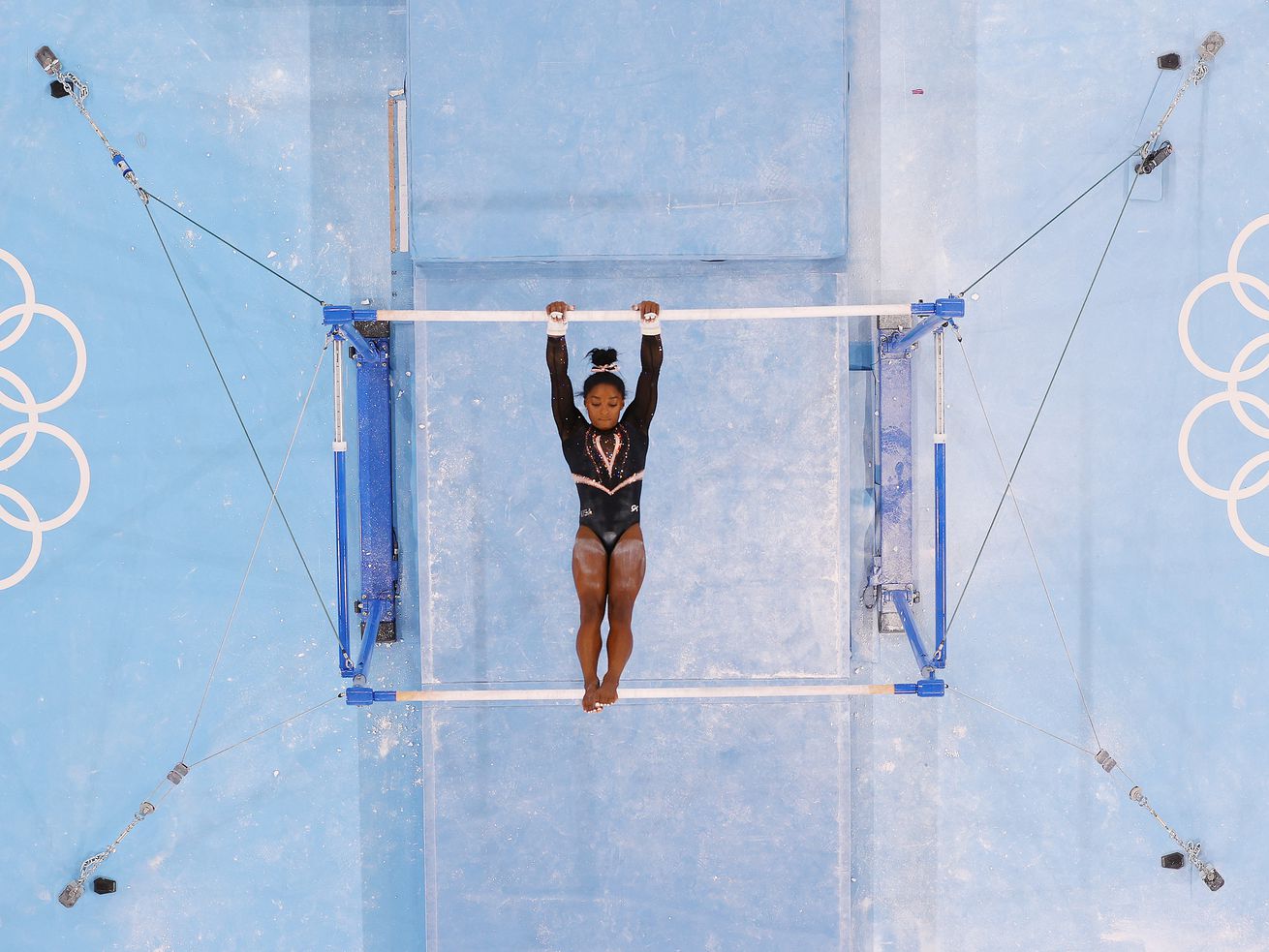Simone Biles is performing the most complicated feats women’s gymnastics has ever seen — and not being fully rewarded for it.
As children, we’re often told that we can do anything we put our minds to. I guess we’re okay with deceiving children because this is a complete lie. No matter how hard we try, there are things Simone Biles can do that none of us will ever achieve.
Over the past eight years, Biles has dominated the competition, winning four Olympic gold medals and 19 world championship medals and getting four maneuvers named after her. She hasn’t lost a major competition since her debut in 2013, a time when Barack Obama was still president. Her talent at strong tumbling combined with execution has made her a transformative and unsurpassed gymnast — she’s taken a sport that is judged to the decimal and won by full points.
At this year’s Olympics, she’ll be the heavy favorite again. Barring injury or getting locked in her hotel room by a jealous rival, little could stop Biles from adding to her gold medal total.
Hence, Biles’s storyline this year isn’t about whether she’ll win, but whether her skills will be fully appreciated. Specifically, the controversy is that Biles is doing moves that few, if any, gymnasts can do, including her male colleagues. But instead of getting full points for her moves, she and those who watch the sport feel that the judges aren’t scoring her fairly and are not giving her moves their proper value. With Biles’s overall dominance, missing a few tenths here and there can feel trivial. But try to imagine the absurdity of shortchanging greatness and why it’s happening to arguably the greatest athlete of all time.
Simone Biles performs two extremely difficult, underscored skills
To understand the controversy over Biles’s score, you have to understand how scoring in gymnastics works. A gymnast’s score on any apparatus is the combination of an execution score graded out of a perfect 10 and a difficulty or starting value score. The latter is the important thing when it comes to Biles.
A routine’s difficulty score is the sum of all a gymnast’s moves in a routine: the higher the difficulty of the move, the more it’s worth, and the higher the total value goes. Provided you attempt those elements, that difficulty score value is yours to keep. What sets Biles apart from mortals is that her difficulty scores are much higher than those of her competitors.
For example, here’s the scoresheet from the 2019 World Championships in Stuttgart. Take note of the figures next to the (D) from each competitor. That’s the difficulty score, and look how Biles is consistently tallying scores of 6s and above on all four apparatuses. Her competitors don’t have the difficulty.
/cdn.vox-cdn.com/uploads/chorus_asset/file/22714765/Screen_Shot_2021_07_13_at_10.48.05_AM.png) USA Gymnastics
USA GymnasticsThis means that Biles’s potential scores are much higher than her competitors. You’ll also notice that in terms of execution (the “E” scores), she’s executing her harder skills at a similar clip, if not better (e.g. the vault in the first column), than her opponents. So she’s not only performing more difficult routines, but also executing them well. That leads to, as it did at the World Championships, a win by more than 2 points in a sport that — until Simone Biles — was decided by tenths and hundredths of a point.
The current controversy surrounding Biles is that she’s added new, more difficult skills but isn’t getting what should be the full credit reflected in her difficulty score. One of those moves is her vault, which has the difficulty value of 6.6.
.@Simone_Biles successfully completed a Yurchenko double pike in vault at last night’s #USClassic.
She is the first woman in HISTORY to perform the move in competition. @OnHerTurf pic.twitter.com/j07ZweTA0f
— #TokyoOlympics (@NBCOlympics) May 23, 2021
“Simone does something that’s called a Yurchenko double pike, which is misleading because she’s actually doing three complete flips during the vault,” said Dave Lease, who runs the gymnastics and figure skating site The Skating Lesson. “This is something that only a handful of men can do without serious bodily harm. She actually did the vault extremely well. But the judges went conservative on the score.”
The other element, as Lease points out, is her dismount off the balance beam: a double-twisting, double-back.
“The double-twisting double on the floor is what Shawn Johnson and Jordyn Wieber were mounting their floor routines with. Ending this off the balance beam is truly mind-boggling,” Lease said.
Johnson and Wieber were Olympic gold medalists in 2008 and 2012, respectively. At their peak, both were considered two of the best gymnasts in the world and, like Biles, they shined in events like the floor routine, which showcases a gymnast’s power and tumbling skills. Biles has taken their best floor routine move and is performing it on a completely different apparatus, a 4-inch-wide platform.
There you have it, folks! @Simone_Biles successfully landed her signature double-double dismount on beam today and the element will be named the “Biles” from now on. #Stuttgart2019 pic.twitter.com/BO38BaCQ8g
— Team USA (@TeamUSA) October 5, 2019
Regardless of how mind-boggling or death-defying her elements appear, some gymnastics insiders say that both elements deserve to be scored higher. Lease says that he would score her around two-tenths higher on both elements and that even her floor routine is underscored. Biles herself said she believes that the International Gymnastics Federation (IGF) and judges are underscoring the elements.
“They’re both too low and they even know it,” Biles told the New York Times in May. “But they don’t want the field to be too far apart. And that’s just something that’s on them. That’s not on me.”
Simone Biles and American dominance in gymnastics have some haters
The IGF has no explanation for why Biles is scored the way she is, but as the New York Times pointed out, one of the reasons inferred was a safety issue. By underscoring Biles, it could have a chilling effect in which other gymnasts don’t attempt those skills and decrease the risk of harming themselves.
A problem with this argument is that there are a lot of skills in gymnastics that aren’t safe. Underscoring some moves doesn’t necessarily make sense in a sport where risk is inherent and handsomely rewarded.
What Biles told the New York Times seems to be a more believable explanation: that by underscoring Biles, the IGF can keep the competition closer and Biles less dominant.
The last time Biles lost a major competition was in 2013 when she first started competing at the Senior level. Since then, it’s been gold medals in every all-around (the individual portion of a competition) and team finals. She’s arguably the most dominant athlete in any sport. But the bonkers thing about her dominance is that Biles turned gymnastics into a sport defined by the slimmest of margins and absolute drama into blowouts. Adding more points to her difficulty would mean even bigger demolitions.
And while she is currently the apex athlete in gymnastics, she’s part of an American dynasty that goes back to 2012. After nabbing silver in the 2008 team competition, the US clinched gold in 2012, thrashed the competition in 2016, and are heavy favorites to win again in 2021.
Lease told me that in 2016, the American team was so stacked that they could have invited anyone as the fourth member and they still would have won. That team won by an astronomical 8 points.
For 2021, “it remains that your next-door neighbor could have been the last person on the team. With Simone, Jordan Chiles, and Sunni Lee, it doesn’t really matter,” Lease said.
Biles was a huge part of that 2016 win and will be a huge part of 2021’s competition. But the US’s key to winning has been to outscore teams in power events like the vault (e.g. McKayla Maroney and the rest of the US team landing the “Amanar” vault in 2012) and floor exercise (e.g. Biles, Wieber, and Aly Raisman’s powerful, high-scoring routines) and to keep pace on their traditionally weaker event, the uneven bars. American dominance has proven that highly difficult, well-executed power gymnastics is a winning formula, but it’s drawn criticism from purists who say the current scoring system is robbing artistry from the sport.
“What happened is that the gymnasts who are good at tumbling and doing really difficult skills wound up being more rewarded than they would have been in the past,” Lease said. “I think that there is some potential backlash from other countries about the athleticism of Americans racking up so many points with tumbling. Yeah, but that’s the way the rules are written. And they pushed through those rules do not have judging scandals, and the Americans are just better at it!”
Sometimes that ire manifests itself in explicitly racist ways, like in Biles’s 2013 debut: Italian gymnast Carlotta Ferlito made a comment that she and her teammates should have donned blackface to win. Ferlito’s federation backed her up, with its spokesperson David Ciaralli saying at the time:
Carlotta was talking about what she thinks is the current gymnastics trend: the Code of Points is opening chances for colored people (known to be more powerful) and penalizing the typical Eastern European elegance, which, when gymnastics was more artistic and less acrobatic, allowed Russia and Romania to dominate the field
Valeri Liukin, who is the former coordinator of the US women’s gymnastics team and current coach of Brazil’s women’s team, said in a 2019 interview that the current scoring system favors black athletes because they’re more “explosive”:
But yes, gymnastics is changing. In the Code of Points, difficulty is very valued now. Of course, this suits African Americans. They’re very explosive — look at the NBA, who’s playing and jumping there?
Yikes!
What these generalizations missed are extremely talented white athletes like Wieber and Raisman who preceded Biles and benefited from the current scoring system as well as 2012 all-around gold medalist Gabby Douglas, who beat out the likes of Wieber and Raisman and is considered a finesse gymnast. The comments fit a pattern of how transcendent Black athletes (see: the Williams sisters) are spoken about in crude and pseudoscientific terms — that their greatness stems from blackness as a kind of physical advantage rather than greatness being a product of talent, hard work, and practice.
Biles’s underscoring is something that we’d find ridiculous in any other sport, Lease notes. He covers figure skating primarily, a close cousin of gymnastics because it’s also a sport whose elements are subjective and graded. The equivalent would be penalizing skaters for landing “quads” (jumps with four revolutions). And it’s even more absurd when you compare the situation to other sporting events.
“It’s telling Michael Jordan to score 20 points per game and no more,” he said. “You watched the Michael Jordan documentary, right? This is like Justice for John Stockton, who’s just not as good. It’s like if in the early 2000s, we told Venus and Serena [Williams] ‘let’s not break 100 miles per hour, please.’ Could you imagine that?”
I, for one, couldn’t imagine that. But as the gymnastics competition begins, we may all see it for ourselves. And see if and how Biles perseveres.
Author: Alex Abad-Santos
Read More



